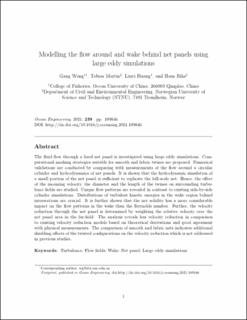| dc.contributor.author | Wang, Gang | |
| dc.contributor.author | Martin, Tobias | |
| dc.contributor.author | Huang, Liuyi | |
| dc.contributor.author | Bihs, Hans | |
| dc.date.accessioned | 2021-10-01T06:27:09Z | |
| dc.date.available | 2021-10-01T06:27:09Z | |
| dc.date.created | 2021-09-30T09:54:23Z | |
| dc.date.issued | 2021 | |
| dc.identifier.citation | Ocean Engineering. 2021, 239 . | en_US |
| dc.identifier.issn | 0029-8018 | |
| dc.identifier.uri | https://hdl.handle.net/11250/2786838 | |
| dc.description.abstract | The fluid flow through a fixed net panel is investigated using large eddy simulations. Computational meshing strategies suitable for smooth and fabric twines are proposed. Numerical validations are conducted by comparing with measurements of the flow around a circular cylinder and hydrodynamics of net panels. It is shown that the hydrodynamic simulation of a small portion of the net panel is sufficient to replicate the full-scale net. Hence, the effect of the incoming velocity, the diameter and the length of the twines on surrounding turbulence fields are studied. Unique flow patterns are revealed in contrast to existing side-by-side cylinder simulations. Distributions of turbulent kinetic energies in the wake region behind intersections are crucial. It is further shown that the net solidity has a more considerable impact on the flow patterns in the wake than the Reynolds number. Further, the velocity reduction through the net panel is determined by weighting the relative velocity over the net panel area in the far-field. The analysis reveals less velocity reduction in comparison to existing velocity reduction models based on theoretical derivations and good agreement with physical measurements. The comparison of smooth and fabric nets indicates additional shielding effects of the twisted configurations on the velocity reduction which is not addressed in previous studies. | en_US |
| dc.language.iso | eng | en_US |
| dc.publisher | Elsevier | en_US |
| dc.rights | Attribution-NonCommercial-NoDerivatives 4.0 Internasjonal | * |
| dc.rights.uri | http://creativecommons.org/licenses/by-nc-nd/4.0/deed.no | * |
| dc.subject | Havbruk | en_US |
| dc.subject | Aquavulture | en_US |
| dc.title | Modelling the flow around and wake behind net panels using large eddy simulations | en_US |
| dc.type | Peer reviewed | en_US |
| dc.type | Journal article | en_US |
| dc.description.version | acceptedVersion | en_US |
| dc.rights.holder | This is the authors' accepted manuscript to an article published by Elsevier. Locked until 23-9-2023 due to copyright restrictions. The AAM is made available under the CC-BY-NC-ND 4.0 license http://creativecommons.org/licenses/by-nc-nd/4.0/ | en_US |
| dc.subject.nsi | VDP::Marin teknologi: 580 | en_US |
| dc.subject.nsi | VDP::Marine technology: 580 | en_US |
| dc.source.pagenumber | 22 | en_US |
| dc.source.volume | 239 | en_US |
| dc.source.journal | Ocean Engineering | en_US |
| dc.identifier.doi | 10.1016/j.oceaneng.2021.109846 | |
| dc.identifier.cristin | 1941121 | |
| dc.relation.project | Notur/NorStore: NN2620K | en_US |
| cristin.ispublished | true | |
| cristin.fulltext | postprint | |
| cristin.qualitycode | 1 | |

